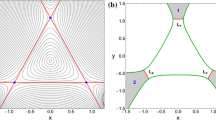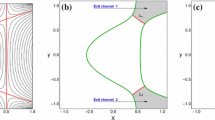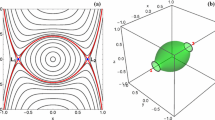Abstract
The Hénon–Heiles potential is undoubtedly one of the most simple, classical and characteristic Hamiltonian systems. The aim of this work was to reveal the influence of the value of the total orbital energy, which is the only parameter of the system, on the different families of orbits, by monitoring how the percentage of chaotic orbits, as well as the percentages of orbits composing the main regular families evolve when energy varies. In particular, we conduct a thorough numerical investigation distinguishing between ordered and chaotic orbits, considering only bounded motion for several energy levels. The smaller alignment index (SALI) was computed by numerically integrating the equations of motion as well as the variational equations to extensive samples of orbits in order to distinguish safely between ordered and chaotic motion. In addition, a method based on the concept of spectral dynamics that utilizes the Fourier transform of the time series of each coordinate is used to identify the various families of regular orbits and also to recognize the secondary resonances that bifurcate from them. Our exploration takes place both in the physical \((x,y)\) and the phase \((y,\dot{y})\) space for a better understanding of the orbital properties of the system. It was found that for low energy levels, the motion is entirely regular being the box orbits the most populated family, while as the value of the energy increases chaos and several resonant families appear. We also observed, that the vast majority of the resonant orbits belong in fact in bifurcated families of the main 1:1 resonant family. We have also compared our results with previous similar outcomes obtained using different chaos indicators.










Similar content being viewed by others
Notes
If \(S\) is the \(2N\) dimensional phase space (four dimensional, in our case) where the orbits of a dynamical system evolve on, then a deviation vector \(\mathbf{w}\), which describes a small perturbation of a specific orbit \(\mathbf{x}\), evolves on a \(2N\) dimensional space \(T_{x}S\) tangent to \(S\).
Generally, dynamical methods are broadly split into two types: (i) those based on the evolution of sets of deviation vectors in order to characterize an orbit and (ii) those based on the frequencies of the orbits which extract information about the nature of motion only through the basic orbital elements without the use of deviation vectors.
For every orbital family there is a parent (or mother) periodic orbit, that is, an orbit that describes a closed figure. Perturbing the initial conditions which define the exact position of a periodic orbit we generate quasi-periodic orbits that belong to the same orbital family and librate around their closed parent periodic orbit.
It is known that in dynamical systems with a finite energy of escape where escape is possible (open Hamiltonian systems), chaos appears and dominates at values of energy very close to the critical escape energy which determines the transition from bounded to unbounded motion.
References
Aguirre, J., Vallejo, J.C., Sanjuán, M.A.F.: Wada basins and chaotic invariant sets in the Hénon–Heiles system. Phys. Rev. E 64, 066208-1–066208-11 (2001)
Aguirre, J., Sanjuán, M.A.F.: Limit of small exits in open Hamiltonian systems. Phys. Rev. E 67, 056201-1–056201-7 (2003)
Aguirre, J., Vallejo, J.C., Sanjuán, M.A.F.: Wada basins and unpredictability in Hamiltonian and dissipative systems. Int. J. Mod. Phys. B 17, 4171–4175 (2003)
Aguirre, J., Viana, R.L., Sanjuán, M.A.F.: Fractal structures in nonlinear dynamics. Rev. Mod. Phys. 81, 333–386 (2009)
Armbruster, D., Guckenheimer, J., Kim, S.: Chaotic dynamics in systems with square symmetry. Phys. Lett. A 140, 416–420 (1989)
Barrio, R.: Sensitivity tools vs. Poincaré sections. Chaos Solitons Fractals 25, 711–726 (2005)
Barrio, R., Blesa, F., Serrano, S.: Fractal structures in the Hénon–Heiles Hamiltonian. Europhys. Lett. 82, 10003-1–10003-6 (2008)
Barrio, R., Blesa, F., Serrano, S.: Bifurcations and safe regions in open Hamiltonians. New J. Phys. 11, 053004-1–053004-12 (2009)
Binney, J., Spergel, D.: Spectral stellar dynamics. ApJ 252, 308–321 (1982)
Binney, J., Spergel, D.: Spectral stellar dynamics. II. The action integrals. MNRAS 206, 159–177 (1984)
Binney, J., Tremaine, S.: Galactic Dynamics, 2nd edn. Princeton University Press, Princeton (2008)
Blesa, F., Seoane, J.M., Barrio, R., Sanjuán, M.A.F.: To escape or not to escape, that is the question—perturbing the Hénon–Heiles Hamiltonian. Int. J. Bifurcat. Chaos 22, 1230010-1–1230010-9 (2012)
Caranicolas, N.D., Barbanis, B.: Periodic orbits in nearly axisymmetric stellar systems. A&A 114, 360–366 (1982)
Caranicolas, N.D., Zotos, E.E.: Unveiling the influence of dark matter in axially symmetric galaxies. PASA 30, 49-1–49-14 (2013)
Carpintero, D.D., Aguilar, L.A.: Orbit classification in arbitrary 2D and 3D potentials. MNRAS 298, 1–21 (1998)
Chang, Y.F., Tabor, M., Weiss, J.: Analytic structure of the Hénon-Heiles Hamiltonian in integrable and nonintegrable regimes. J. Math. Phys. 23, 531–538 (1982)
Coccollo, M., Seoane, J.M., Sanjuán, M.A.F.: Controlling unpredictability in the randomly driven Hénon–Heiles system. Commun. Nonlinear Sci. Numer. Simul. 18, 3449–3457 (2013)
Conte, R., Musette, M., Verhoeven, C.: Explicit integration of the Hénon–Heiles Hamiltonians. J. Nonlinear Math. Phys. 12, 212–227 (2005)
Contopoulos, G., Barbanis, B.: Resonant systems with three degrees of freedom. A&A 153, 44–54 (1985)
Contopoulos, G., Magnenat, P.: Simple three-dimensional periodic orbits in a galactic-type potential. CeMec 37, 387–414 (1985)
Contopoulos, G., Mertzanides, C.: Inner Lindblad resonance in galaxies: nonlinear theory. II. Bars. A&A 61, 477–485 (1977)
de Moura, A.P.S., Letelier, P.S.: Fractal basins in Hénon–Heiles and other polynomial potentials. Phys. Lett. A 256, 362–368 (1999)
Fordy, A.P.: The Hénon–Heiles system revisited. Physica D 52, 204–210 (1991)
Hénon, M., Heiles, C.: The applicability of the third integral of motion: some numerical experiments. Astron. J. 69, 73–79 (1964)
Lees, J.F., Schwarzschild, M.: The orbital structure of galactic halos. ApJ 384, 491–501 (1992)
Meyer, K.R., Hall, G.R.: Introduction to Hamiltonian Dynamical Systems and the N-Body Problem. Springer, New York (1992)
Muzzio, J.C., Carpintero, D.D., Wachlin, F.C.: Spatial structure of regular and chaotic orbits in a self-consistent triaxial stellar system. CeMDA 91, 173–190 (2005)
Press, H.P., Teukolsky, S.A., Vetterling, W.T., Flannery, B.P.: Numerical Recipes in FORTRAN 77, 2nd edn. Cambridge University Press, Cambridge (1992)
Ravoson, V., Gavrilov, L., Caboz, R.: Separability and Lax pairs for Hénon–Heiles system. J. Math. Phys. 34, 2385–2393 (1993)
Seoane, J.M., Aguirre, J., Sanjuán, M.A.F., Lai, Y.C.: Basin topology in dissipative chaotic scattering. Chaos 16, 023101-1–023101-8 (2006)
Seoane, J.M., Sanjuán, M.A.F., Lai, Y.C.: Fractal dimension in dissipative chaotic scattering. Phys. Rev. E 76, 016208-1–016208-6 (2007)
Seoane, J.M., Sanjuán, M.A.F.: Exponential decay and scaling laws in noisy chaotic scattering. Phys. Lett. A 372, 110–116 (2008)
Seoane, J.M., Huang, L., Sanjuán, M.A.F., Lai, Y.C.: Effects of noise on chaotic scattering. Phys. Rev. E 79, 047202-1–047202-4 (2009)
Seoane, J.M., Sanjuán, M.A.F.: Escaping dynamics in the presence of dissipation and noisy in scattering systems. Int. J. Bifurcat. Chaos 9, 2783–2793 (2010)
Šidlichovský, M., Nesvorný, D.: Frequency modified Fourier transform and its applications to asteroids. CeMDA 65, 137–148 (1996)
Skokos, C.: Alignment indices: a new, simple method for determining the ordered or chaotic nature of orbits. J. Phys. A Math. Gen. 34, 10029–10043 (2001)
Toda, M.: Vibration of a chain with nonlinear interaction. J. Phys. Soc. Jpn. 22, 431–436 (1967)
Wojciechowski, S.: Separability of an integrable case of the Henon–Heiles system. Phys. Lett. A 100, 277–278 (1984)
Zotos, E.E.: Revealing the evolution, the stability and the escapes of families of resonant periodic orbits in Hamiltonian systems. Nonlinear Dyn. 73, 931–962 (2013)
Zotos, E.E., Caranicolas, N.D.: Revealing the influence of dark matter on the nature of motion and the families of orbits in axisymmetric galaxy models. A&A 560, 110-1–110-8 (2013)
Zotos, E.E., Caranicolas, N.D.: Determining the nature of orbits in disk galaxies with non spherical nuclei. Nonlinear Dyn. 76, 323–344 (2014)
Zotos, E.E., Carpintero, D.D.: Orbit classification in the meridional plane of a disk galaxy model with a spherical nucleus. CeMDA 116, 417–438 (2013)
Acknowledgments
The author would like to express his warmest thanks to all the anonymous referees for the careful reading of the manuscript and for all the apt suggestions and comments which allowed us to improve both the quality and the clarity of the paper.
Author information
Authors and Affiliations
Corresponding author
Rights and permissions
About this article
Cite this article
Zotos, E.E. Classifying orbits in the classical Hénon–Heiles Hamiltonian system. Nonlinear Dyn 79, 1665–1677 (2015). https://doi.org/10.1007/s11071-014-1766-6
Received:
Accepted:
Published:
Issue Date:
DOI: https://doi.org/10.1007/s11071-014-1766-6




